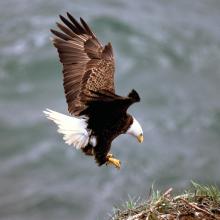Image set

Related services
Opening article section
Article section
Headline
Rich text
Eagles carry out reproductive cycles the species needs to survive, and they will often return to the same nesting sites each year. This can be problematic (and dangerous) when their nests are located on or adjacent to worksites. At Englobe, we make it our mission to care about the world around us, and our experts are trained in species at risk conservation.
“Each year, on World Wildlife Day, we celebrate the beauty and wonder of our planet’s wild plants and animals (…) Ecosystems are only healthy when their component species thrive. If just one keystone species disappears, an entire ecosystem can start to decline and die.” – Antonio Guterres, United Nations Secretary-General. (World Wildlife Day)
Meet Michaela Haring
To learn more about what Englobe is doing to protect species at risk, we spoke with Michaela Haring, Biologist and Project Manager in Sudbury, Ontario. With some of our clients, Michaela is hired as a resident, on site consultant biologist to prepare management plans or standard operating procedures (SOPs), ensuring that species conservation is a consideration in their plans.
What conservation initiatives have you been working on these days?
I have the opportunity to work on really interesting projects at Englobe! Most recently, we received authorization from the Ministry of Northern Development, Mines, Natural Resources and Forestry (NDMNRF) to remove an eagle’s nest from a mining company’s extraction site. The work involves creating an artificial nesting structure to replace it, to be installed further away from the site so the eagles will be encouraged to nest in a safe place.
What are some of the unique challenges you encounter with this type of work?
The main challenge with habitat compensation is to find the right place to put the new habitats and basically encourage the eagles to nest elsewhere. It has to be a location that is conducive to where they typically nest – often in tall trees (what we call “super canopy trees”) and near water that provides them with a good fishing source.
How do the eagles know where their nest has been moved to? Do they sense it/smell it?
Actually, most species of birds have little to no sense of smell. I do know eagles have excellent eyesight, so I would suspect they likely utilize visual cues in their landscape to find their nest from the previous year. The fact that their nests are in “super canopy” trees and in close vicinity to water probably helps them with locating their nesting site. That is why we look for those features when selecting the location of the replacement nesting platform.
Media
Image set

Rich text
How does moving this single eagle’s nest make a significant difference in the conservation efforts of the species?
Actually, for this specific project, there are a total of four nests including one eagle’s, as well as osprey and owl nests. But eagles are what we call a “special concerned” species as they have the potential to become endangered in the future. In this instance, we are being asked to relocate the nests because they are currently in an active mine site.
Eagles carry out reproductive cycles the species needs to survive, and they will often return to the same nesting sites each year. Sometimes they build alternative nests in other locations, but typically, they will return to the same area each year. So, what we try to do is encourage them to stay in a suitable long-term habitat where they will be safe.
How can people who don’t work in this field help?
It’s important for people to be aware of the regulations about species at risk, especially big industries and the owners and operators of industrial and commercial property. Eagles are deemed protected and their nests are as well. If a developer has a project going on, for example, and they spot one or several nests on the work site, it’s their obligation to contact the Ministry before attempting to remove them on their own. There are certain conditions to abide by and usually, they’ll contact a company like Englobe who offers this kind of expertise. And it doesn’t just apply to eagles or other birds – people should get familiar with the right process to follow for all species at risk.
Can you give us some insight into what you’ll be working on next?
Currently, there are lots of species at risk (SAR) studies going on at Englobe: I am regularly involved in bat monitoring and bird point count surveys, the objective of which is to assess avian composition and diversity in a given area. It involves recording observations of all species seen or heard over a five or ten-minute time period.
Certain mining companies that go into closure and want to rehabilitate their sites count on our team of professionals to do it in a way that promotes biodiversity and allows these animal species to flourish.
This summer will likely bring many new projects for Englobe biologists. It’s an area of the business that’s expanding with increased demand year after year, so who knows? Our team might be growing in the future, which would put us in a better position to protect species at risk.
Media
Image set
